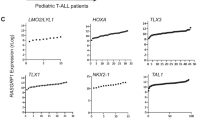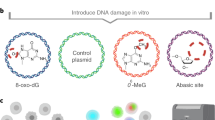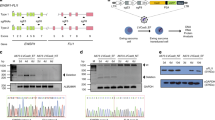Abstract
We have developed a novel dual-fluorescence reporter system incorporating green (GFP) and red (RFP) fluorescent proteins to monitor expression of the N-rasm gene and an N-rasm suppressor, respectively. Retroviral vectors were produced in which human N-rasm (codon 13 mutation) was coexpressed with GFP, and a ribozyme specifically targeting N-rasm was coexpressed with RFP. N-Rasm suppression was monitored by measurement of GFP fluorescence in dual-fluorescent (GFP and RFP) cells. We demonstrated that the degree of N-rasm suppression was dependent on the ribozyme dose, proportional to red fluorescence, in dual-fluorescent cells. We further showed that ribozyme-mediated N-rasmsuppression inhibited growth of NIH3T3 and CD34-positive TF-1 cells. In these cultures, ras suppressor activity resulted in the depletion of suppressor-positive cells due to inhibition of cell growth. In contrast, N-rasm suppression produced a growth advantage to human leukemic K562 cells, presumably by inhibiting N-rasm-induced apoptosis. In K562 cells, ras suppression resulted in the outgrowth of suppressor-positive cells. This provides a platform to identify suppressors of ras that is based on function.
This is a preview of subscription content, access via your institution
Access options
Subscribe to this journal
Receive 12 print issues and online access
$259.00 per year
only $21.58 per issue
Buy this article
- Purchase on Springer Link
- Instant access to full article PDF
Prices may be subject to local taxes which are calculated during checkout









Similar content being viewed by others
References
Appelbaum FR, Rowe JM, Radich J, Dick JE . Acute myeloid leukemia. Hematology (Am Soc Hematol Educ Program). 2001;62–86.
Bonnet D, Dick JE . Human acute myeloid leukemia is organized as a hierarchy that originates from a primitive hematopoietic cell. Nat Med. 1997;3:730–737.
Lapidot T, Sirard C, Vormoor J, et al. A cell initiating human acute myeloid leukaemia after transplantation into SCID mice. Nature. 1994;367:645–648.
Farr CJ, Saiki RK, Erlich HA, McCormick F, Marshall CJ . Analysis of RAS gene mutations in acute myeloid leukemia by polymerase chain reaction and oligonucleotide probes. Proc Natl Acad Sci USA. 1988;85:1629–1633.
Bartram CR, Ludwig WD, Hiddemann W, et al. Acute myeloid leukemia: analysis of ras gene mutations and clonality defined by polymorphic X-linked loci. Leukemia. 1989;3:247–256.
Radich JP, Kopecky KJ, Willman CL, et al. N-ras mutations in adult de novo acute myelogenous leukemia: prevalence and clinical significance. Blood. 1990;76:801–807.
Bos JL, Toksoz D, Marshall CJ, et al. Amino-acid substitutions at codon 13 of the N-ras oncogene in human acute myeloid leukaemia. Nature. 1985;315:726–730.
Bos JL, Verlaan-de Vries M, van der Eb AJ, et al. Mutations in N-ras predominate in acute myeloid leukemia. Blood. 1987;69:1237–1241.
Janssen JW, Steenvoorden AC, Lyons J, et al. RAS gene mutations in acute and chronic myelocytic leukemias, chronic myeloproliferative disorders, and myelodysplastic syndromes. Proc Natl Acad Sci USA. 1987;84:9228–9232.
Vogelstein B, Civin CI, Preisinger AC, et al. RAS gene mutations in childhood acute myeloid leukemia: a Pediatric Oncology Group study. Genes Chromosomes Cancer. 1990;2:159–162.
Paquette RL, Landaw EM, Pierre RV, et al. N-ras mutations are associated with poor prognosis and increased risk of leukemia in myelodysplastic syndrome. Blood. 1993;82:590–599.
Miyauchi J, Asada M, Sasaki M, Tsunematsu Y, Kojima S, Mizutani S . Mutations of the N-ras gene in juvenile chronic myelogenous leukemia. Blood. 1994;83:2248–2254.
Flotho C, Valcamonica S, Mach-Pascual S, et al. RAS mutations and clonality analysis in children with juvenile myelomonocytic leukemia (JMML). Leukemia. 1999;13:32–37.
Scherr M, Grez M, Ganser A, Engels JW . Specific hammerhead ribozyme-mediated cleavage of mutant N-ras mRNA in vitro and ex vivo. Oligoribonucleotides as therapeutic agents. J Biol Chem. 1997;272:14304–14313.
Scherr M, Maurer AB, Klein S, Ganser A, Engels JW, Grez M . Effective reversal of a transformed phenotype by retrovirus-mediated transfer of a ribozyme directed against mutant N-ras. Gene Therapy. 1998;5:1227–1234.
Scharovsky OG, Rozados VR, Gervasoni SI, Matar P . Inhibition of ras oncogene: a novel approach to antineoplastic therapy. J Biomed Sci. 2000;7:292–298.
Su Z, Lebedeva IV, Gopalkrishnan RV, et al. A combinatorial approach for selectively inducing programmed cell death in human pancreatic cancer cells. Proc Natl Acad Sci USA. 2001;98:10332–10337.
Funato T, Ishii T, Kambe M, Scanlon KJ, Sasaki T . Anti-K-ras ribozyme induces growth inhibition and increased chemosensitivity in human colon cancer cells. Cancer Gene Ther. 2000;7:495–500.
Zhang YA, Nemunaitis J, Scanlon KJ, Tong AW . Anti-tumorigenic effect of a K-ras ribozyme against human lung cancer cell line heterotransplants in nude mice. Gene Therapy. 2000;7:2041–2050.
Gibbs JB . Anticancer drug targets: growth factors and growth factor signaling. J Clin Invest. 2000;105:9–13.
Du W, Liu A, Prendergast GC . Activation of the PI3'K-AKT pathway masks the proapoptotic effects of farnesyltransferase inhibitors. Cancer Res. 1999;59:4208–4212.
Misteli T, Spector DL . Applications of the green fluorescent protein in cell biology and biotechnology. Nat Biotechnol. 1997;15:961–964.
Gross LA, Baird GS, Hoffman RC, Baldridge KK, Tsien RY . The structure of the chromophore within DsRed, a red fluorescent protein from coral. Proc Natl Acad Sci USA. 2000;97:11990–11995.
Heikal AA, Hess ST, Baird GS, Tsien RY, Webb WW . Molecular spectroscopy and dynamics of intrinsically fluorescent proteins: coral red (dsRed) and yellow (Citrine). Proc Natl Acad Sci USA. 2000;97:11996–12001.
Dolnikov A, Ward RL, Hawkins NJ, Symonds G . Apoptosis in v-myc transformation of myelomonocytic cells and its modulation by CSF-1. Oncogene. 1996;12:1189–1198.
Acknowledgements
We thank Dr M Grez for the generous supply of N-rasm encoding plasmid and Johnson & Johnson Research for facility space and staff discussions. GS is a Principal Research Fellow of the NHMRC of Australia and this work was funded by a project grant of the NHMRC.
Author information
Authors and Affiliations
Corresponding author
Rights and permissions
About this article
Cite this article
Dolnikov, A., Shen, S., Millington, M. et al. A sensitive dual-fluorescence reporter system enables positive selection of ras suppressors by suppression of ras-induced apoptosis. Cancer Gene Ther 10, 745–754 (2003). https://doi.org/10.1038/sj.cgt.7700603
Revised:
Published:
Issue Date:
DOI: https://doi.org/10.1038/sj.cgt.7700603



